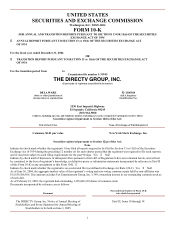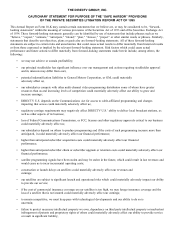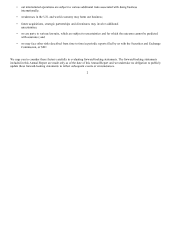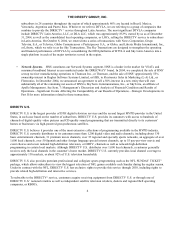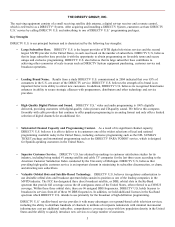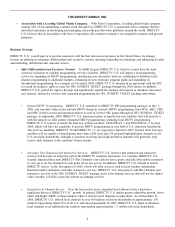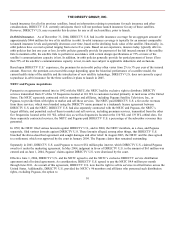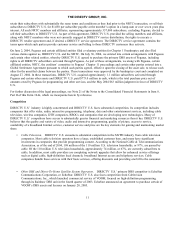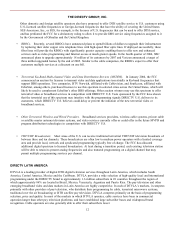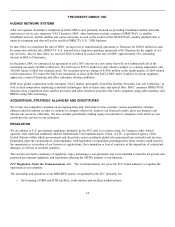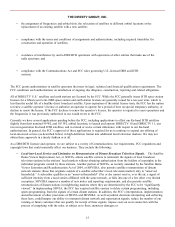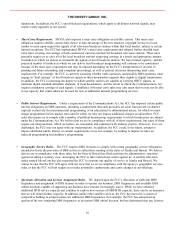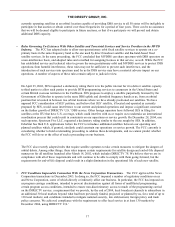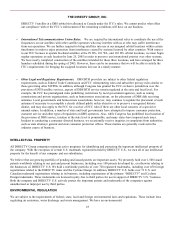DIRECTV 2004 Annual Report Download - page 19
Download and view the complete annual report
Please find page 19 of the 2004 DIRECTV annual report below. You can navigate through the pages in the report by either clicking on the pages listed below, or by using the keyword search tool below to find specific information within the annual report.
THE DIRECTV GROUP, INC.
launch insurance for all of its previous satellites, based on information relating to premiums for such insurance and other
considerations, DIRECTV U.S. currently anticipates that it will not purchase launch insurance for any of these satellites.
However, DIRECTV U.S. may reconsider this decision for any or all such satellites, prior to launch.
In-Orbit Insurance. As of December 31, 2004, DIRECTV U.S. had in-orbit insurance coverage for an aggregate amount of
approximately $466 million for two of its satellites in orbit. In-orbit insurance coverage is typically for an amount comparable
to launch insurance levels and generally decreases over time, based on the declining book value of the satellite. Historically, in-
orbit policies have covered a period ranging from one to five years. Based on our experience, insurers today typically offer in-
orbit policies that last one year or less. In-orbit policies generally provide for payment of the full insured amount if the satellite
fails to maintain orbit, the satellite fails to perform in accordance with certain design specifications or 75% or more of the
satellite’s communications capacity is lost. In addition, in-orbit policies generally provide for partial payment of losses if less
than 75% of the satellite’s communications capacity is lost, in each case subject to applicable deductions and exclusions.
Based upon DIRECTV U.S.’ experience, the premium for an in-orbit policy often varies from 2% to 3% per year of the insured
amount. However, the premium can exceed this range depending upon the historical performance of a satellite model, the
current health status of the satellite and the introduction of new satellite technology. DIRECTV U.S. does not currently expect
to purchase in-orbit insurance for the three satellites it plans to launch in 2005.
NRTC and Pegasus Acquisitions
Pursuant to an agreement entered into in 1992 with the NRTC, the NRTC had the exclusive right to distribute DIRECTV
services transmitted from 27 of the 32 frequencies located at 101 WL to customers located primarily in rural areas of the United
States. The NRTC separately contracted with its members and affiliates, including Pegasus Satellite Television, Inc., or
Pegasus, to provide them with rights to market and sell these services. The NRTC paid DIRECTV U.S. a fee on the revenues
from these services, which were branded using the DIRECTV name pursuant to a trademark license agreement between
DIRECTV U.S. and the NRTC. DIRECTV U.S. had also separately contracted with the NRTC and Pegasus, the NRTC’s
largest affiliate, and permitted each of them to market and sell services, including premium services, transmitted from the other
five frequencies located at the 101 WL orbital slot, as well as frequencies located at the 110 WL and 119 WL orbital slots. For
these separately contracted services, the NRTC and Pegasus paid DIRECTV U.S. a percentage of the subscriber revenues they
generated.
In 1999, the NRTC filed various lawsuits against DIRECTV U.S., and in 2000, the NRTC members, as a class, and Pegasus
separately, filed various lawsuits against DIRECTV U.S. These lawsuits alleged, among other things, that DIRECTV U.S.
breached the above-described agreement and sought damages and other relief. In August 2003, the NRTC and the class agreed
to a settlement, which was approved by the court in January 2004. The Pegasus claims then remained outstanding.
Separately in 2001, DIRECTV U.S. sued Pegasus to recover $54 million plus interest, which DIRECTV U.S. claimed Pegasus
owed to it under the marketing agreement. In May 2004, judgment in favor of DIRECTV U.S. in the amount of $63 million was
entered and on June 1, 2004, Pegasus’ claims against DIRECTV U.S. were dismissed by the court.
Effective June 1, 2004, DIRECTV U.S. and the NRTC agreed to end the NRTC’s exclusive DIRECTV service distribution
agreement and all related agreements. As consideration, DIRECTV U.S. agreed to pay the NRTC $4.4 million per month
through June 2011. As a result of this agreement, DIRECTV U.S. now has the right to sell its services in all territories across the
United States. Additionally, DIRECTV U.S. provided the NRTC’s 96 members and affiliates who possessed such distribution
rights, excluding Pegasus, the option to
10


